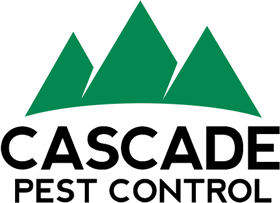Author: Kurt Treftz, Cascade Pest Control
While spring may turn a young man’s fancy to thoughts of love, it turns a bug’s thoughts to food and reproduction. As the weather warms, you may find the outdoor world flooded with buzzing, humming, creeping, jumping, and crawling insects. Spring is the time to stop an infestation before it starts, so keep your eyes open for some common pests. In fact, diligence in the spring can often stop a late summer pest infestation before it gets started.
Stinging Pests: Bees & Wasps
While you might not see quite as many bees and wasps in the spring as you do in late summer, now is the time to pay attention. If you can prevent them from building colonies and nests early, then you will have fewer problems later. As you are soaking up the spring sun, keep your eyes open. Follow the path of wasps and bees to see where they go. If they appear to be making themselves comfortable in your roof, close to your home, or under decks and porches, it is better to take action now.
But don’t mistake all long, frightening wasps as dangerous. Many regions of the US, including the Seattle area, are home to the stump stabber wasp. With its large size, striped body, and long “stinger” these creatures look intimidating. However, the “stinger” is not a stinger at all. Instead, the female uses it to stab into dead wood and deposit her eggs. It is very rare for them to sting.
Another insect common to Washington state is the Buffalo Treehopper. They are related to the cicada although they look nothing alike. Instead, like the stump stabber, they deposit their eggs inside stems or leaves, primarily of oak trees. When the eggs hatch, the nymphs feed on the tree, often damaging it. Therefore, it is wise to eradicate these pests before they do damage.
Stinky Pests: Stink Bugs
As soon as the weather starts to warm, this pungent pest makes an appearance. Stink bugs begin to lay their eggs, which hatch in 5-15 days. While they start small, they soon become mature adults. And. . . well, they stink. While they might be tolerated outdoors, you certainly don’t want them making their way inside. If you have a garden, check for sunken areas that might indicate the presence of these bugs. Stop them before they get out of hand.
Swarming Pests: Mayflies
The mayfly is a common, springtime pest that can quickly get out of hand. While these flies have an incredibly short adult lifespan of around 24 hours, they can live for a couple of years as larvae. The larvae live underwater so they are common around lakes, ponds, etc. However, when they emerge, they do so in such large numbers as to be truly disruptive. They don’t cause direct harm to humans and animals but piles and piles of dead Mayflies can be found littering the ground – even making driving difficult. By taking action early, especially in areas with water, you can prevent this pest from becoming a nuisance
Serviceable Pests: Snakefly, Water Strider, Devil’s Coach Horse Beetle
Some springtime insects found around the area are actually beneficial and should be encouraged. You may already be aware of the benefits from praying mantises, ladybugs, damsel bugs, and others. But here are a few springtime helpers you might not think about.
The snakefly (named for its snake-like head and long wings) is a “pest” that feeds on grubs that might otherwise eat your plants, flowers, or grass roots.
The water strider (an insects which actually does walk on water thanks to its specially designed legs with thousands of tiny hairs) lives on the water. They are helpful in eating mosquitos and their larvae so you might want to keep them around.
Devil’s Coach Horse Beetle is a long name for a black beetle that also feeds on slugs, worms, spiders, and other pests that might wreak havoc on your garden. They are named after British folklore which claimed that when the threatened beetle curled its tail and emitted an odor, you would be cursed by the devil.
Spinning Pests: Spiders
There is a reason that Halloween decorations often include spider webs – autumn is a prime time for these eight-legged creatures to make their way indoors. But spring can often see an outdoor blossoming of spiders as the weather warms. An abundance of food/flies can keep them plenty happy outdoors, so if possible, leave them alone and let them benefit you by eating other insects.
Spending time in the sun and in your own yard should be a joy of springtime. Don’t let pests keep you from enjoying it. Contact Cascade Pest Control for all your pest control needs.
Call 888-989-8979!
